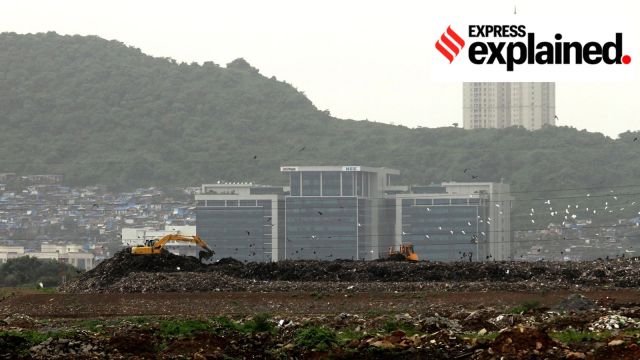Bombay HC declares Kanjurmarg a ‘protected forest’: the story of the disputed landfill site
The SLF facility in Kanjurmarg, which became operational in 2016, receives the major share of the solid waste processed in Mumbai daily. Senior officials fear shutting this place overnight could bring the city to a standstill. Here is what to know.
 Out of the 6,500 MT of solid waste generated daily in Mumbai, around 5,900 MT is sent to Kanjurmarg for scientific treatment, while the rest goes to the Deonar dumpyard. The landfill site currently houses 20 lakh MT of solid waste. (Express File Photo)
Out of the 6,500 MT of solid waste generated daily in Mumbai, around 5,900 MT is sent to Kanjurmarg for scientific treatment, while the rest goes to the Deonar dumpyard. The landfill site currently houses 20 lakh MT of solid waste. (Express File Photo)The Bombay High Court (HC) on May 2 declared a 119.91-hectare portion of the larger 141.77-hectare landfill at Kanjurmarg, Mumbai, as a ‘protected forest’ under the Forest Conservation Act (FCA) 1980, and the Indian Forest Act 1927. It thus quashed a 2009 directive of the state government ‘denotifying’ its forest status.
This ruling presents a challenge for the Brihanmumbai Municipal Corporation (BMC) as the Kanjurmarg facility serves as the city’s lone sanitary landfill (SLF) or disposal facility. Senior officials fear shutting this place overnight could bring the city to a standstill, considering 90% of Mumbai’s daily solid waste goes to the Kanjurmarg facility for treatment.
The SLF facility in Kanjurmarg, which became operational in 2016, receives the major share of the solid waste processed in Mumbai daily. Out of the 6,500 MT of solid waste generated daily in Mumbai, around 5,900 MT is sent to Kanjurmarg for scientific treatment, while the rest goes to the Deonar dumpyard. The landfill site currently houses 20 lakh MT of solid waste.
Meanwhile, civic and court records accessed by The Indian Express reveal that the Supreme Court’s 2003 order enabled the allotment of the land parcel to the BMC for solid waste management. Since then, the site has been at the centre of legal disputes for the past two decades.
How the Kanjurmarg site was chosen
In the early 2000s, the BMC had four land parcels in the city at Deonar, Chincholi Bunder (Malad), Gorai, and Mulund, used as dumpsites for solid waste. All four facilities had been operational since the 20th century, when the majority of erstwhile Bombay’s population inhabited the island city and the suburban belt was considered the city’s ‘outskirts’. As time passed and the city’s demography transformed, its population in the suburbs swelled. In 2001, residents’ associations from Malad and nearby areas moved the court demanding that an alternate space at the city’s outskirts be used as a landfill.
In 2003, the SC directed the central government to allocate 141.7 hectares of a 283-hectare salt pan land parcel in Kanjurmarg to Maharashtra for use as a sanitary landfill. The salt pan is located in the marshy land that adjoins the Thane-Airoli creek and is densely populated with mangroves.
“The government of Maharashtra will hand over the land to BMC within a period of three months from today. On completion of all the formalities regarding transfer, the said land be used as a dumping subject to strict observance of environment laws and the dumping ground which is operational at Chincholi Bunder should be discontinued,” read the SC’s order.
The state administration did not act on this order for two years, prompting the Bombay HC to intervene to immediately hand over this land to the civic authorities.
“As per the directions given by the HC, the land at Kanjurmarg admeasuring 141.77 hectares has been handed over to the BMC for using it as a dumping ground,” read the state government’s note that was submitted to the HC following the handing over that took place in October 2005.
The contentious ‘protected forest’ status
In 2005, the Maharashtra government moved to notify 5,469 hectares of mangroves in and around Mumbai as “protected forests”, complying with a 2005 HC order directing the state to recognise all mangroves on state-owned land accordingly. The 141.77-hectare Kanjurmarg site was thus notified as a “protected forest” given its dense population of mangroves, as a marshy land close to the creek.
However, a year later, the state government “denotified” the 141.77-hectare land in Kanjurmarg as forest land and permitted the BMC to use it as a landfill. In 2010, the BMC floated tenders to establish the Kanjurmarg land parcel as a sanitary landfill and waste processing facility. However, it took seven years to finalise the contractor and complete the construction of the facility, readying it for operation only in 2016.
In 2013, Vanashakti, a Mumbai-based NGO, filed a PIL in the HC challenging the state’s decision to reverse the ‘protected forest’ status the site previously enjoyed, and questioning the Union Environment Ministry’s decision to grant the environment clearance.
Stalin D, director of Vanashakti, told The Indian Express that his NGO had filed four different petitions against the dumpsite. He said their initial petition with the National Green Tribunal secured a stay on landfill activities, but was later challenged by the BMC in the High Court. The court ordered that no other court should hear this matter, he said.
“The legal dispute went on for 12 years… The final hearing was held in July last year, and the ruling came eight months later in May 2025,” Stalin said. “As of today, only one petition has been disposed of. The remaining three petitions challenge the current usage of methodology, site selection, violation of rules and the process of obtaining EC. The BMC was permitted to use the site as a sanitary landfill. However, these rules are not followed as garbage is dumped in the open, and one can smell the stench from a distance,” he added.
The following course of action
The BMC will approach the SC challenging the HC’s May 2 judgement. The civic officials also maintained that waste disposal will continue in the interim at the Kanjurmarg site.
“We will be filing a special leave petition (SLP) at the SC. The court can only give one of the two judgements – either banning the usage of the plot as a dumping ground or allowing us to continue using it,” Kiran Dighavkar, Deputy Municipal Commissioner, Solid Waste Management (SWM), told The Indian Express.
“If the court orders us to vacate the land, then we will seek time to find an alternate place where waste can be dumped and processed regularly. In the meantime, we will also need time to clear the Kanjurmarg land via bio-mining. We will inform the SC that there is a crisis of land in Mumbai. And if dumping of waste in Kanjurmarg is stopped overnight, without giving us an alternative, then Mumbai may come to a standstill as 90% of the city’s waste goes there for processing every day,” Dighavkar said.
Photos



- 01
- 02
- 03
- 04
- 05



































